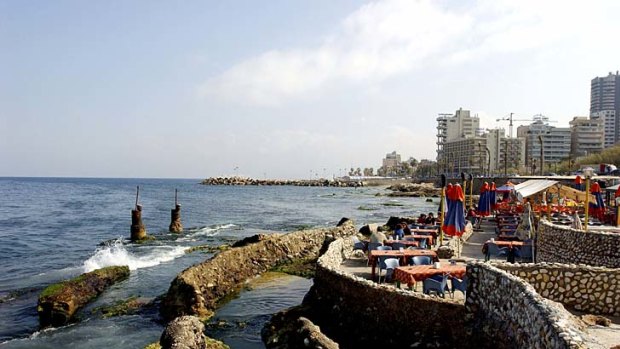
World's most thrilling place to be? A stroll along the Corniche reveals more and more people creating the buzz and excitement of a new Beirut.Credit: Getty Images
Lebanon's capital is fast becoming one of the most exciting cities on Earth, writes Ian Henderson.
OUT of my Beirut hotel window the jumble of history is everywhere. A ruined Ottoman fort and an exquisite Maronite chapel are immediately outside. Concrete blocks from the infamous Green Line, which used to divide the city, are scattered among fallen Roman columns. On the skyline, mosques and churches - there are about 18 official religions in Lebanon - frame the skeleton of the old Holiday Inn, a target for anyone with a rocket launcher during the civil war, which ended 11 years ago.
When friends knew I was going to Beirut, the reaction was split between those who see it as the most thrilling place to be - the Next Big Thing - and those who haven't got past seeing it as a war zone where well-meaning travellers end up chained to radiators.
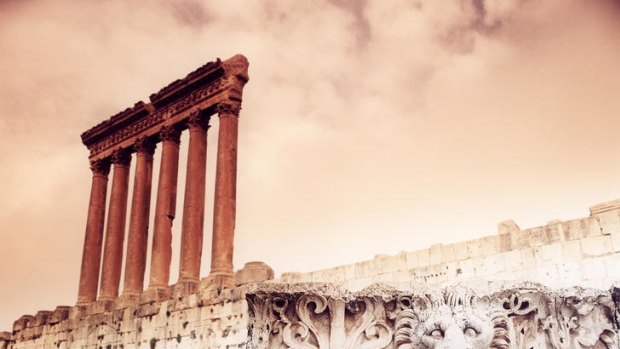
Jumble of history ... the Baalbek ruins.Credit: Getty Images
Both have a point. Style pundits are noisily buying up apartments and rightly singing the praises of Lebanese musicians and designers while Hezbollah and Israeli jets still fight it out around them. The Green Line is rapidly being built over in the shiny new Downtown district and it's often hard to tell which is a shelled building and which is a construction site.
People I spoke with in Beirut are astonishingly matter-of-fact about Lebanon's recent past, telling stories of homes and lives destroyed; yet at the same time they are insistent that the world should look at Beirut not through the eyes of the American writer P.J. O'Rourke (it featured in his book, Holidays in Hell) but as a hopeful, optimistic and thriving place that is fast reinventing itself.
The tiny Maronite chapel is just in front of the huge new Blue Mosque and there's a perfectly restored Orthodox church next to a Catholic cathedral. Perhaps surprisingly, given recent tensions, the synagogue is being restored, too. And all these are within yards of each other, every one getting the same attention from the stonemasons and painters and all in streets where you might find a Ferrari dealer next to a funky bar or a sharp designer next to a flat-bread stall. Some serious money is coming into Beirut.
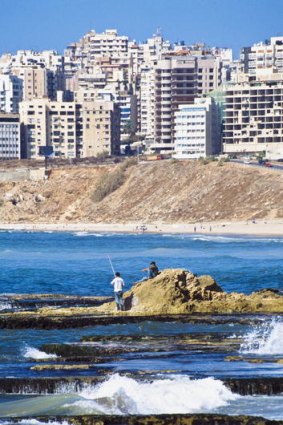
Beirut's expanding coastline.Credit: Getty Images
Sleek steel and glass buildings are rising around Downtown, some people have enough money to risk their Porsches among the beaten-up Mercedes taxis that veer honking across the streets (the horn being preferred to wing mirrors) and hoardings around building sites along the Corniche proudly trumpet the return of Beirut's glamorous '60s heyday with pictures of carefree film stars and Riva speedboats.
The hotelier Gordon Campbell Gray's successes with One Aldwych in London and Carlisle Bay in Antigua suggest he knows an opportunity when he sees one. His latest venture, Le Gray, is one of Beirut's newest and chicest hotels. Gray talks about the "kindness industry" and its positive effects for Beirut and Lebanon, though he's far from blind to the risks. We sat in the comfortable Cigar Bar before dinner and watched the smart young Lebanese mixing with the international visitors - they aren't defined by the conflicts of the past.
Next day on the waterfront we met one of them, Kamal Mouzawak, who calls his brand of entrepreneurialism "gastroeconomics" (motto, make food not war). Believing that in a world of increasing global sameness people and cultures are defined most closely by their culinary heritage, he encourages real farmers' markets where the actual producers (rather than resellers) come in from the countryside with fresh vegetables, preserves, fruits and natural remedies.
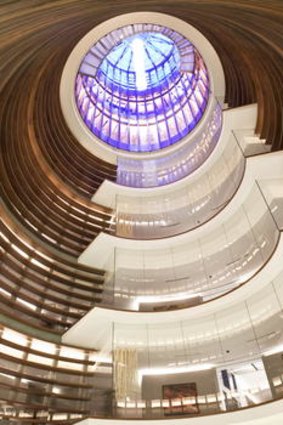
The Le Gray hotel.Credit: AFP
He has also opened the wonderful Tawlet Cafe, where each day a different cook will compose a menu from fresh local ingredients in airy surroundings of white tiles, wooden shelves, clever recycled lighting and fresh flowers.
It's far beyond the familiar baba ganoush and shawarma street food - from the daunting raw liver and lamb (eaten with a pinch of salt and paprika) through to freekeh (roasted green wheat) and delicious ricotta, coal-tasting Armenian basturma (dried meat cured with spices) and 961 beer.
A stroll past the beach clubs of the Corniche or an evening in the bars and restaurants of Gemmayze reveal more and more people creating the buzz and excitement of a new Beirut. Coffee shops and ice-cream parlours, sports bars and music venues seem to be opening daily among the elegant Parisian-style buildings. And if you're brave enough to tackle the crazy driving on the roads towards Damascus and the Bekaa Valley, you can find more evidence of people building a new economy from the ruins of the old.
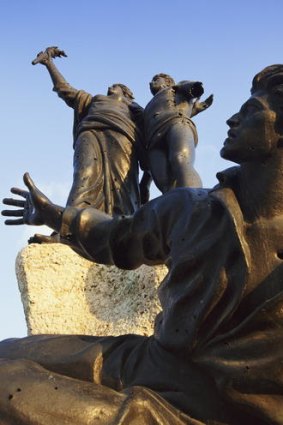
The Martyrs Statue.Credit: Getty Images
Sami and Ramzi Ghosn's El Massaya winery is an example. Deep in Hezbollah territory (you can tell by the yellow-and-black flags flying by the roadblocks) a drive down a couple of dusty tracks past industrial units and abandoned buildings takes you into a lavender-scented vineyard surrounded by olive trees and rustling poplars. Starting from scratch in 1998, the Ghosns set themselves the task of rivalling better-known Lebanese wineries such as Chateau Musar.
With help from well-known French winemakers and undaunted by conflict, they've done it - you can find their excellent wines at British merchants and on exclusive London wine lists.
The brothers' shady garden and little restaurant is a perfect place to enjoy a sunny afternoon, especially if you've been touring the extraordinary ruins at Baalbek on the way. The ancient city of Heliopolis is one of the best-preserved and most important ancient sites of the region and despite earthquakes and almost two millennia of looting it is still breathtaking. The "small temple" is bigger than the Parthenon in Athens and has exquisite carvings still in amazing condition, while the six columns still standing of the vast Temple of Jupiter are the tallest ever discovered. Even on a Sunday morning the only other visitors were a group of women, their black hijabs stark against the vast white stones.
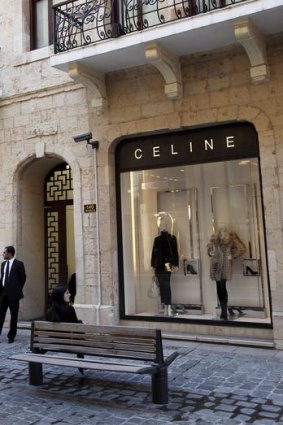
Shopping in Solidere.Credit: Getty Images
We took a longer route back to the city, avoiding the swerving trucks and maniacal motorcyclists of the main road, passing over the mountains (where Beirutis come to ski in winter) through pines and cedars. One side effect of the country's entrepreneurialism is that there are a lot of unplanned and often unfinished building projects dotted randomly across the hills, while driving into the city takes you through some areas where the benefits of a restarted economy have yet to be felt - cheap shops, broken pavements and unfixed buildings. But despite vintage US army tanks and well-armed soldiers being part of the street furniture in some areas, there's nowhere that feels unsafe.
Nevertheless, it's a pleasure to be back in the quietly sophisticated comfort of Le Gray to reflect on the Beirut experience - maybe with a visit to the spa or over dinner in one of the fine restaurants. The hotel is an expression of confidence in the future, just like El Massaya, the glossy shops of Downtown, the bars of Gemmayze and the Souk el Tayeb farmers' market.
Leave your preconceptions at home and you'll find Beirut to be one of the most exciting and welcoming cities on Earth.
Trip notes
Getting there
Emirates and Etihad fly from Sydney to Beirut, via Dubai and Abu Dhabi respectively.
Touring there
Peregrine Tours has an eight-day Highlights of Lebanon tour from $1590 a person, twin share. 1300 791 485, peregrineadventures.com.
World Expeditions has a five-day Lebanon Explorer for $1590 a person. 1300 720 000, worldexpeditions.com.
Intrepid Tours has an eight-day Explore Lebanon tour for $1150 a person. 1300 360 887, www.intrepidtravel.com.
Staying there
35 Rooms New, welcoming and not too expensive, located in vibrant Hamra, close to the American University of Beirut. From $US110 ($107) to $US300. + 961 1 345 676, 35rooms.com.
Le Gray Gordon Campbell Gray's attention to detail extends to every aspect of this chic, relaxed city hotel. From about $US360. + 961 1 962 828, www.legray.com.
Need to know
In this city of squealing tyres, you must concentrate hard to avoid getting run over — traffic lights mean nothing.
You're marginally safer in a taxi — but don't go anywhere without first asking the price.
At archaeological sites you'll find lots of ancient Roman relics being sold. Don't buy them: few are genuine.
As with any politically unstable country, check the federal government's advice at smartraveller.gov.au.
Eat + drink
Gemmayze Try the streets of Gemmayze for a mix of bars and restaurants. Find Al Qazar, Mir and Godot. Take it from there until dawn at the SkyBar.
Tawlet Changing cooks bring changing flavours to this "gastroeconomic movement" — and the results are superb. Beirut, sector 79 Naher Street, No 12; + 961 1 448 129.
Indigo on the Roof A cosmopolitan restaurant drawing on the best in Lebanese and international cuisine. Le Gray Hotel, des Martyrs; + 961 196 2828.
More information
lebanon-tourism.gov.lb; Lonely Planet's guidebook.
Six things to do
-
The National Museum has fine archaeological treasures; make sure you see the film Revival, about the city's recovery.
-
Get a temporary membership at one of the beach clubs — they will be a lot cleaner than the public beach and people-watching is much improved.
-
Check out the farmers' market on Saturday morning in Saifi for superb fresh produce from the local area.
-
Don't miss the Roman Baths, Cardo Maximus, the Blue Mosque and the little Maronite church near Le Gray.
-
There are plenty of smart shops in Downtown selling local labels such as Elie Saab and Zuhair Murad.
-
For a more bohemian feel, head for the cafes and galleries of Hamra, close to the American University of Beirut.
- The Sunday Telegraph, London
Sign up for the Traveller Deals newsletter
Get exclusive travel deals delivered straight to your inbox. Sign up now.